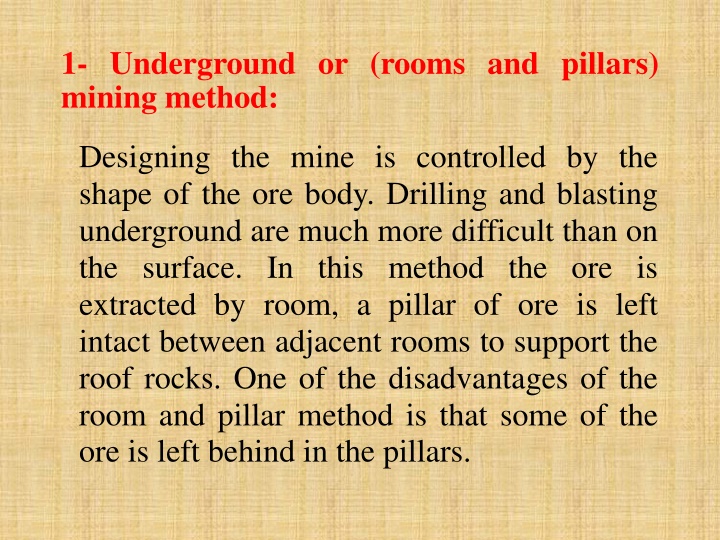
Mining Methods and Mineral Processing Technology
Learn about underground and surface mining methods, including room and pillar mining and open-pit mining. Explore the stages of mineral processing technology, such as crushing, specific gravity separation, and froth flotation. Understand the physical methods of separating valuable ore particles from barren rock.
Download Presentation

Please find below an Image/Link to download the presentation.
The content on the website is provided AS IS for your information and personal use only. It may not be sold, licensed, or shared on other websites without obtaining consent from the author. If you encounter any issues during the download, it is possible that the publisher has removed the file from their server.
You are allowed to download the files provided on this website for personal or commercial use, subject to the condition that they are used lawfully. All files are the property of their respective owners.
The content on the website is provided AS IS for your information and personal use only. It may not be sold, licensed, or shared on other websites without obtaining consent from the author.
E N D
Presentation Transcript
1- Underground or (rooms and pillars) mining method: Designing the mine is controlled by the shape of the ore body. Drilling and blasting underground are much more difficult than on the surface. In this method the ore is extracted by room, a pillar of ore is left intact between adjacent rooms to support the roof rocks. One of the disadvantages of the room and pillar method is that some of the ore is left behind in the pillars.
2- Surface or open-pit mining method: This method use where deposit occurs at or near the surface. An open-pit mine is a big hole in the ground with a series of step like terraces (benches) round the excavation, this is known strip mining. Drilling and blasting is required to loosen hard overburden material, it is removed to expose the ore deposits. The slope angle of the pit sides is controlled by the rocks properties (hard or soft). The gentle slope in soft rocks more than in hard. The space of terrace (bench) is allow shovels to move and load the ore into transport vehicles. The ratio of waste rock (overburden rock) to the ore deposit is known as the stripping ratio.
Mineral Processing Technology (Treatment and Beneficiation): The stages involves vary from one ore to another, different kinds and grades of ore need different treatments. Mineral processing is concerned mainly with the physical methods of separation:
1- Crushing and grains (particles) size separation: Crushing is involving the mechanical breakdown of the large lumps of mined ore into small fragments. The main purpose of the processing is to liberate the valuable particles of ore from the barren rock. The primary crusher is to reduce the size from 50cm to 20-10cm. The secondary crusher breaks down the particles to 2- 0.5cm. These small fragments next was grinding by steel ball mill to take the ore between 300-100 m. The concentrating processes exploit differences in hardness between particles of minerals, soft minerals as small particles, hard minerals as larger. Grains separate about size by sieve analysis (handing or shaker) or sedimentation instruments. or by centrifuge
2- Specific gravity separation: Separation depend on specific gravity differences of minerals due to mass effects. Minerals are separated by heavy liquids like carbon tetrachloride (CCl4) (sp. gr. 1.58), bromoform (sp. Gr. 2.89), methylene iodide (sp. Gr. 3.72). 3- Froth Flotation separation: Separation utilizing physiochemical properties of the minerals, froth flotation as air bubbles. the different surface
4- Electrical conductivity separation: Separation depend on electrical conductivity properties, it use to separate conducting (Au, Cu, & Ag) from non-conducting (S & C) or semi-conducting (Si & Ge). 5- Thermal treatment separation: Like calcination of carbonate or sulphate to prepare lime or plaster 6- Magnetic separation: Separation depend on magnetic properties, ferromagnetic minerals like magnetite (Fe3O4), paramagnetic minerals like hematite (Fe2O3) and diamagnetic minerals like pyrite (FeS2). Magnetic separation is an beneficiation of iron ores, bauxite ore, silica sand, kaolin clays. important process in the
